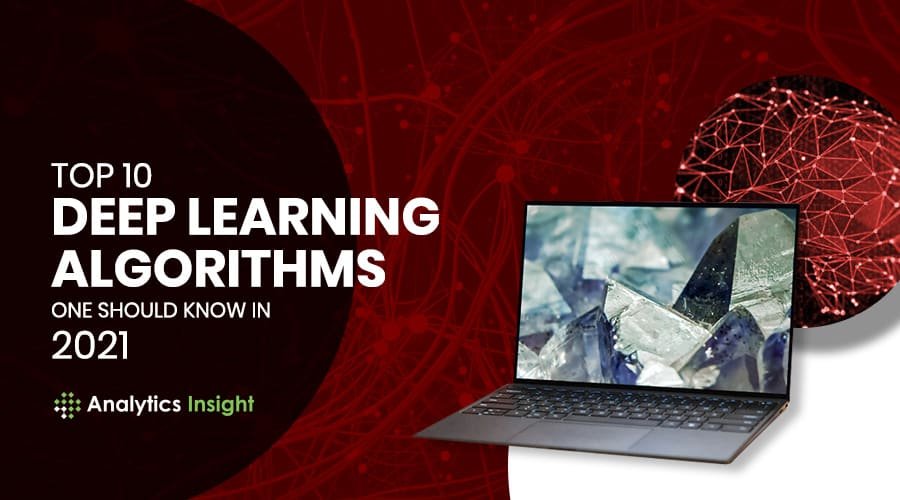Source – https://www.analyticsinsight.net/
The following are the most important deep learning algorithms that programmers should know about in 2021.
Deep learning algorithms train machines and it uses artificial neural networks to perform sophisticated computations on large amounts of data. It is a type of machine learning that works based on the structure-function of the human brain. While deep learning algorithms feature self-learning representations, they depend upon ANNs that mirror the way the brain computes information.
- EVOLUTIONARY DEEP INTELLIGENCE IS DEEP LEARNING’S NEW ADVANCEMENT
- AI AND DEEP LEARNING INTEGRATIONS IN MERGERS & ACQUISITIONS
- THESE ARE THE TOP APPLICATIONS OF DEEP LEARNING IN HEALTHCARE
Convolutional Neural Network
CNN’s, also known as ConvNets, consist of multiple layers and are mainly used for image processing and object detection. Yann LeCun developed the first CNN in 1988 when it was called LeNet. It was used for recognizing characters like ZIP codes and digits. CNN’s are widely used to identify satellite images, process medical images, forecast time series, and detect anomalies
Long Short Term Memory Networks
LSTMs are a type of Recurrent Neural Network (RNN) that can learn and memorize long-term dependencies. Recalling past information for long periods is the default behavior. LSTMs retain information over time. They are useful in time-series prediction because they remember previous inputs. LSTMs have a chain-like structure where four interacting layers communicate uniquely. Besides time-series predictions, LSTMs are typically used for speech recognition, music composition, and pharmaceutical development.
Recurrent Neural Networks
RNNs have connections that form directed cycles, which allow the outputs from the LSTM to be fed as inputs to the current phase. The output from the LSTM becomes an input to the current phase and can memorize previous inputs due to its internal memory. RNNs are commonly used for image captioning, time-series analysis, natural-language processing, handwriting recognition, and machine translation.
Generative Adversarial Networks
GANs are generative deep learning algorithms that create new data instances that resemble the training data. GAN has two components: a generator, which learns to generate fake data, and a discriminator, which learns from that false information. The usage of GANs has increased over some time. They can be used to improve astronomical images and simulate gravitational lensing for dark-matter research. Video game developers use GANs to upscale low-resolution, 2D textures in old video games by recreating them in higher resolutions via image training.
Radial Basis Function Network
RBFNs are special types of feedforward neural networks that use radial basis functions as activation functions. They have an input layer, a hidden layer, and an output layer and are mostly used for classification, regression, and time-series prediction.
Multilayer Perceptions
MLPs are an excellent place to start learning about deep learning technology. MLPs belong to the class of feedforward neural networks with multiple layers of perceptrons that have activation functions. MLPs consist of an input layer and an output layer that is fully connected. They have the same number of input and output layers but may have multiple hidden layers and can be used to build speech recognition, image recognition, and machine-translation software.
Self Organizing Maps
Professor Teuvo Kohonen invented SOMs, which enable data visualization to reduce the dimensions of data through self-organizing artificial neural networks. Data visualization attempts to solve the problem that humans cannot easily visualize high-dimensional data. SOMs are created to help users understand this high-dimensional information.
Deep Belief Network
DBNs are generative models that consist of multiple layers of stochastic, latent variables. The latent variables have binary values and are often called hidden units. DBNs are a stack of Boltzmann Machines with connections between the layers, and each RBM layer communicates with both the previous and subsequent layers. Deep Belief Networks (DBNs) are used for image recognition, video recognition, and motion-capture data.
Restricted Boltzmann Machine
Developed by Geoffrey Hinton, RBMs are stochastic neural networks that can learn from a probability distribution over a set of inputs. This deep learning algorithm is used for dimensionality reduction, classification, regression, collaborative filtering, feature learning, and topic modeling. RBMs constitute the building blocks of DBNs.
Autoencoders
Autoencoders are a specific type of feedforward neural network in which the input and output are identical. Geoffrey Hinton designed autoencoders in the 1980s to solve unsupervised learning problems. They are trained neural networks that replicate the data from the input layer to the output layer. Autoencoders are used for purposes such as pharmaceutical discovery, popularity prediction, and image processing.
